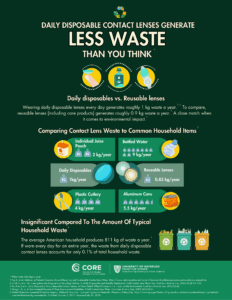
How much waste is generated from wearing daily disposable contact lenses?
Some things in our daily lives set the rhythm of our day. It might start with coffee in the morning and end with scrolling your phone before falling asleep. As a contact lens wearer, putting your lenses in and taking them out will be another one of those routines you probably don’t think too much about, much like brushing your teeth.
We all love the convenience of daily disposable contact lenses: no cleaning, being able to keep some spare lenses in your gym bag, or simply knowing you have a fresh lens every single time you wear lenses. But when you finish another box of lenses and reach for the new box, have you ever wondered how much (or little) waste comes from wearing your daily disposables?
The wider context
First, let’s put things into perspective: how much household waste does the average person make every year anyway? Data from 2018 to 2020 reveals that the average person disposes between 286kg to 811kg of waste a year (Figure 1) and this varies tremendously by country. 1-3



Comparisons to other daily life actions
Second, how much waste is generated from things we might do every day, such as drinking, eating, and snacking? One study found that drinking one 591ml bottle of water every day produces 9 kg of waste per year, whereas wearing a new pair of daily disposable contact lenses every single day produces only 1 kg of waste over the year.4,5 Similarly, using a set of plastic cutlery every day, and daily consumption of a beverage in an aluminium can or a juice pouch all far exceed the amount of waste per year compared to daily wear of daily disposable or reusable contact lenses (lenses that can be kept for up to a month, with care products factored in).
And back to that morning coffee: drinking a takeaway coffee in a single-use cup every day for one whole year generates 60 kg plastic.6
Figure 1: The amount of waste arising from daily consumption of single-use beverages and utensils is far greater than the amount of waste arising from daily wear of contact lenses. Data from Routhier et al, 2012.5

Putting it together
References & Resources
1. United States Environmental Protection Agency. National Overview: Facts and Figures on Materials, Wastes and Recycling. Published October 2, 2017. Accessed April 16, 2025.
2. Department for Environment, Food & Rural Affairs (Defra). Digest of Waste and Resource Statistics – 2018 Edition. Published May 2018. Accessed April 16, 2025.
3. Environment and Climate Change Canada. Solid waste diversion and disposal. Published 2023. Accessed April 16, 2025.
4. Smith SL, Orsborn GN, Sulley A, et al. An investigation into disposal and recycling options for daily disposable and monthly replacement soft contact lens modalities. Cont Lens Anterior Eye 2022;45(2):101435.
5. Routhier J, Freitas MD, Hickson-Curran S. Daily disposable versus reusable contact lenses: a close match when it comes to the impact on the environment. Cont Lens Anterior Eye 2012;35:e2.
6. KeepCup. Impact Calculator. Accessed April 16, 2025.





